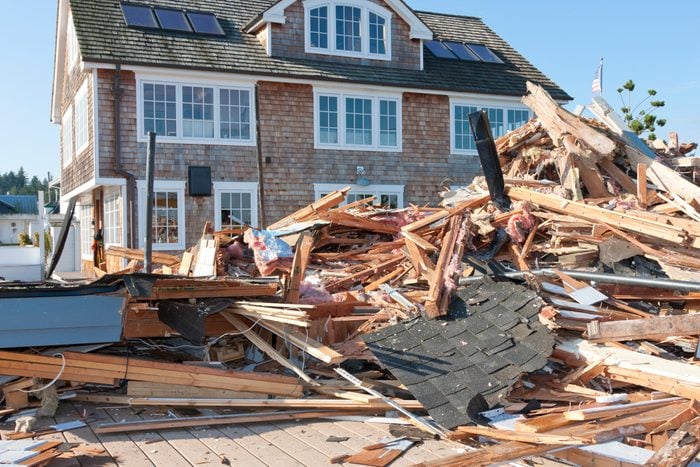What Is Construction Waste and How Can I Reduce It?
Updated: Feb. 12, 2024

Learn about the different types of DIY home construction waste, how to dispose of it and ways to put less in the landfill.
If you’re a DIYer who likes to keep your environmental impact low, consider producing less landfill fodder with your next home project. In 2018 alone, Americans generated 600 million tons of construction waste, according to Environmental Protection Agency (EPA) estimates.
As a DIY property rehabber and owner of a home repair business, I’ve generated my fair share of construction waste over the years. But I’ve also adopted ways to reduce the amount of waste a project generates. Read on to learn what construction waste is and how to reduce it during your next project.
On This Page
What Is Construction Waste?
According to the EPA, construction waste consists of materials “generated when new building and civil-engineering structures are built and when existing buildings and civil-engineering structures are renovated or demolished.”
These materials usually consist of wood, steel, concrete, drywall, masonry, plaster, metal and asphalt waste that comes from houses, large building structures, roads, bridges, piers and dams.
While demolition and construction companies involved in large-scale projects create most of this waste, homeowner DIYers create a lot of it, too, through home renovations and demolition projects.
Types of Construction Waste
Homeowners produce many types during DIY improvement home projects.
Demolition debris
This includes broken concrete, bricks, tiles, drywall, wood and other building materials that result from tearing down or removing existing structures.
Packaging materials
DIY projects often involve purchasing new lumber, tiles, appliances, cabinets or fixtures, which come with packaging materials like cardboard boxes, plastic wrapping, foam packaging and pallets.
Scrap materials
Cut-offs, leftover or unused building materials like lumber, pipes, wires, metal sheets or tiles.
Paint and chemicals
DIY construction may involve painting, staining or various chemicals for cleaning or treatment. Disposal of leftover paint cans, solvents, adhesives or other chemicals should be handled carefully and in compliance with local regulations. Paint and hazardous waste should be separated from other construction debris. Learn how to recycle paint.
Carpet
Carpet, carpet padding and tack strips that have been removed, as well as packaging, unused adhesive and off-cuts from new installations can all be generated during a remodeling project. Waste disposal companies usually require large carpets to be cut into smaller pieces for disposal.
How To Get Rid of Construction Waste
Rent a large trash container
You’ve undoubtedly seen these at residential construction and demo sites. These come in various sizes to accommodate large and small projects, and the rental company removes it when you’re finished. Expect to pay between $300 to $1,000 per week for a construction trash container rental.
Waste management centers
Municipalities often provide drop-off centers or collection services for different types of construction waste. Contact your local waste management authority or nearby private waste disposal company to inquire about specific guidelines for DIY construction waste disposal and cost.
Rates will vary, but the national average at municipal centers is about $52 per ton, according to 2020 figures. Expect to pay more at privately-owned centers.
Hazardous waste disposal centers
These are facilities that collect, store and properly dispose of hazardous materials, like asbestos, lead paint, solvents, paint thinners and unpunctured aerosol cans. Disposal rates will vary by region, amount and material, so check with your local disposal center for prices.
Any construction debris that contains asbestos or lead paint should be removed and disposed of by licensed asbestos and lead abatement companies.
How To Reduce Construction Waste
Plan and design thoughtfully
Before starting any project, carefully plan to minimize unnecessary modifications or rework. This can reduce the amount of waste generated. Get creative and optimize existing square footage instead of building an addition, or use timeless finish materials that don’t require frequent updating.
Measure and order accurately
Take accurate measurements and calculate the required materials to avoid leftovers. Ordering only what you need helps prevent excess waste.
Salvage and reuse
To reduce waste, try deconstruction instead of demolition. Deconstruction means carefully dismantling a building to salvage any reusable materials like doors, cabinets, fixtures and lumber. These items can be repurposed in other areas of your home or donated to organizations that accept used building materials, like Habitat for Humanity’s ReStores.
Sell or donate unwanted items
If you have materials or fixtures still in good condition but no longer needed, consider selling them through local online markets like Facebook Marketplace or Craigslist. If you’d rather donate, look for local “Buy Nothing” Facebook groups.
Buy used materials
Buying used building materials, fixtures and appliances can greatly lessen on the environmental impact of your next project.
Bring to a recycling center
Many areas have facilities that accept construction waste they recycle for repeated use, like concrete, metals and certain plastics. Cardboard packaging materials can also be recycled.
